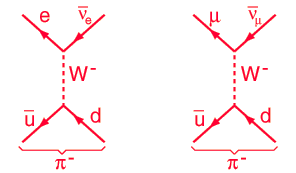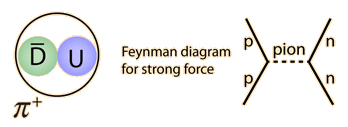| Particle | Symbol | Anti-
particle | Makeup | Rest mass
MeV/c2 | S | C | B | Lifetime | Decay Modes |
| Pion | π+ | π- | ud | 139.6 | 0 | 0 | 0 | 2.60
x10-8 | μ+νμ |
| Pion | π0 | Self |  | 135.0 | 0 | 0 | 0 | 0.83
x10-16 | 2γ |
The neutral pion decays to an electron, positron, and gamma ray by the electromagnetic interaction on a time scale of about 10
-16 seconds. The positive and negative pions have longer lifetimes of about 2.6 x 10
-8 s.

The negative pion decays into a muon and a muon antineutrino as illustrated below. This decay is puzzling upon first examination because the decay into an electron plus an electron antineutrino yields much more energy. Usually the pathway with the greatest energy yield is the preferred pathway. This suggests that some symmetry is acting to inhibit the electron decay pathway.

The symmetry which suppresses the electron pathway is that of angular momentum, as described by Griffiths. Since the negative pion has spin zero, the electron and antineutrino must be emitted with opposite spins to preserve net zero spin. But the antineutrino is always right-handed, so this implies that the electron must be emitted with spin in the direction of its linear momentum (i.e., also right-handed). But if the electron were massless, it would (like the neutrino) only exist as a left-handed particle, and the electron pathway would be completely prohibited. So the suppression of the electron pathway is attributed to the fact that the electron's small mass greatly favors the left-handed symmetry, thus inhibiting the decay. Weak interaction theory predicts that the fraction of muons decaying into electrons should be 1.28 x 10
-4 and the measured branching ratio is 1.23 +/- 0.02 x 10
-4.
The pion, being the lightest meson, can be used to predict the maximum range of the strong interaction. The strong interaction properties of the three pions are identical. The connection between pions and the strong force was proposed by Hideki Yukawa. Yukawa worked out a potential for the force and predicted its mass based on the uncertainty principle from measurements of the apparent range of the strong force in nuclei.
Being composed of an up and an antidown
quark, the positive pion would be expected to have a mass about 2/3 that of a proton, yet it's mass is only about 1/6 of that of the proton! This is an example of how hadron masses depend upon the dynamics inside the particle, and not just upon the
quarks contained.
The pion is a meson. The π+ isconsidered to be made up of anup and an anti-down quark. The neutral pion is considered to be a combination  |  |
Pions interact with nuclei and transform a neutron to a proton or vice versa:

The pions π
+ and π
- have spin zero and negative intrinsic parity (Rohlf Sec 17-2).
























